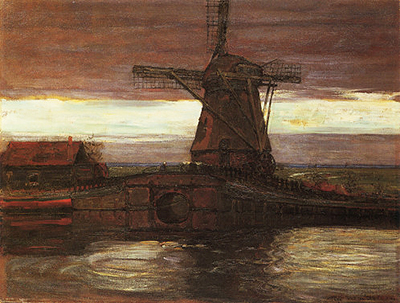This darkly lit landscape painting captures a local Dutch windmill, early in the career of Piet Mondrian. He worked within a fairly traditional style at this point.
The image included in this page is slightly lighter than the original painting in order to allow you to see some more of the detail that would otherwise be impossible to spot in an image of this size. There is a charming bridge alongside the mill, plus a small building which was perhaps for storing the daily farm yield. The view is typically Dutch and in all honesty this painting could have appeared a decade earlier, such is the style used by Mondrian. It was only several years later that he changed his painting approach and at this stage he concentrated on Dutch landscapes, including a number of other paintings of windmills and small rural villages.
The Nelson-Atkins Museum of Art in Kansas City, US owns this painting and it is clearly proud of having an original Mondrian within its collection. It may not be the most famous or renowned art museum in the States, but it still is worth a visit for those in the area and boasts a number of other significant artists within its offering, including works from Francois Boucher, Vincent van Gogh, Claude Monet, William Turner and Eugene Delacroix, who are amongst the most influential European artists of all time. Indeed, Van Gogh himself was known to have been a big influence on Mondrian in his early years.
Colour was always a key part to Mondrian's work, whatever the style in which he was working. At this stage of his career he would experiment with light in many of his landscape paintings, often choosing scenes as sunrise or sunset in order to create dramatic effects where brightness and darkness would clash together abruptly. He would offer us details on the windmill, but in a particularly subtle way, so we could only have a suggestion of it, with darker light disguising areas too.




